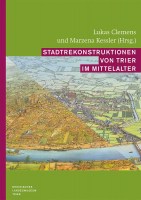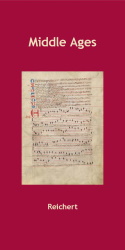Search
Editors: Clemens, Lukas; Kessler, Marzena
Stadtrekonstruktionen von Trier im Mittelalter
2023
17.0 x 24.0 cm, 64 p., 22 illustrations color, 7 illustrations b/w, 3 Beilagen, hardback
ISBN: 9783752007343
17.0 x 24.0 cm, 64 p., 22 illustrations color, 7 illustrations b/w, 3 Beilagen, hardback
15,90 €
ISBN: 9783752007343
Short Description
This volume brings together three reconstructions of medieval Trier, conceived and annotated by Lukas Clemens and Marzena Kessler and realised by the Luxembourg artist Nic Herber. One depiction shows the high medieval tower Jerusalem in the cathedral immunity, whose former appearance can be reliably portrayed on the basis of extensive archaeological and building-historical investigations as well as with the help of early modern pictorial sources. The name of the tower, which is associated with the persecution of the Jews in 1096, is explained, as is its further history, which also includes the fact that Pope Eugene III took up residence in the building when he stayed in Trier in the winter of 1147/48. The two larger representations are reconstructions of general views of Trier from around 1120 and around 1430. These bird's-eye reconstructions are also based on intensive archaeological, architectural and archival research. Two time periods show the processual transformation of a topography that was still shaped by the ancient past, from the archiepiscopal cathedral city to the urban centre administered by the municipality. The first view shows a high medieval town, which was not only characterised by the ruins of large Roman buildings, but also by the remains of ancient residential and commercial buildings. In addition, it can be characterised as a largely agrarian settlement with loose buildings, as many urban areas were cultivated with vineyards and garden crops and used as orchards or fields. Around 1120, Trier was an open city, as the ruinous ancient city fortifications no longer fulfilled their original function and the new high medieval walling was only just being built. Three hundred years later, the urban appearance has fundamentally changed.Due to a far-reaching petrification of the building style that has occurred in the meantime, the ancient remains have been used as quarries and have disappeared. Furthermore, there has been a significant densification of settlements, also due to the establishment of numerous new ecclesiastical institutions, which has led to a more than doubling of the population to around 10,000 inhabitants. With the help of two late medieval property tax lists, it was possible to determine the exact number of houses for most of the alleys of the settlement structure as well as the social and trade structures that once existed there and to evaluate them for the reconstruction.Description
This volume brings together three reconstructions of medieval Trier, conceived and annotated by Lukas Clemens and Marzena Kessler and realised by the Luxembourg artist Nic Herber. One depiction shows the high medieval tower Jerusalem in the cathedral immunity, whose former appearance can be reliably portrayed on the basis of extensive archaeological and building-historical investigations as well as with the help of early modern pictorial sources. The name of the tower, which is associated with the persecution of the Jews in 1096, is explained, as is its further history, which also includes the fact that Pope Eugene III took up residence in the building when he stayed in Trier in the winter of 1147/48. The two larger representations are reconstructions of general views of Trier from around 1120 and around 1430. These bird's-eye reconstructions are also based on intensive archaeological, architectural and archival research. Two time periods show the processual transformation of a topography that was still shaped by the ancient past, from the archiepiscopal cathedral city to the urban centre administered by the municipality. The first view shows a high medieval town, which was not only characterised by the ruins of large Roman buildings, but also by the remains of ancient residential and commercial buildings. In addition, it can be characterised as a largely agrarian settlement with loose buildings, as many urban areas were cultivated with vineyards and garden crops and used as orchards or fields. Around 1120, Trier was an open city, as the ruinous ancient city fortifications no longer fulfilled their original function and the new high medieval walling was only just being built. Three hundred years later, the urban appearance has fundamentally changed.Due to a far-reaching petrification of the building style that has occurred in the meantime, the ancient remains have been used as quarries and have disappeared. Furthermore, there has been a significant densification of settlements, also due to the establishment of numerous new ecclesiastical institutions, which has led to a more than doubling of the population to around 10,000 inhabitants. With the help of two late medieval property tax lists, it was possible to determine the exact number of houses for most of the alleys of the settlement structure as well as the social and trade structures that once existed there and to evaluate them for the reconstruction.Biographical Note
Prof. Dr. Lukas Clemens (born 1961)received his doctorate in 1991 in Trier with the dissertation "Trier - Eine Weinstadt im Mittelalter" (published in 1993). From 1993 to 2004 he was curator for urban archaeology and medieval archaeology at the Rheinisches Landesmuseum Trier. After his habilitation in Mainz in 2000 with the thesis "Tempore Romanorum constructa. Zur Nutzung und Wahrnehmung antiker Überreste nördlich der Alpen während des Mittelalters" (published in 2003), he was appointed to the Chair of Medieval History and Auxiliary Historical Sciences at the University of Trier in 2004. Among his numerous publications, the book "Geschichte der Stadt Trier" (2007), co-authored with Gabriele Clemens, should also be highlighted.
Dr Marzena Kessler (born 1974)
completed her history studies in Krakow (Poland) with a Master's degree. After postgraduate studies in architectural heritage preservation at the University of Applied Sciences Trier, she completed a doctoral programme at the University of Trier in 2011 with the dissertation "Das städtische Bauwesen in Trier am Ende des Mittelalters (1370-1520)" (published in 2015). Marzena Kessler works as a freelance building historian in the field of monument preservation.




 Preface
Preface

 Neuerscheinungen 2023/2024
Neuerscheinungen 2023/2024
 Gesamtverzeichnis 2023/2024
Gesamtverzeichnis 2023/2024
 Katalog Oriental Studies & Linguistics
Katalog Oriental Studies & Linguistics
 Mittelalter
Mittelalter
 Deutsche Inschriften
Deutsche Inschriften
 Musiktherapie
Musiktherapie
 Literaturen im Kontext
Literaturen im Kontext